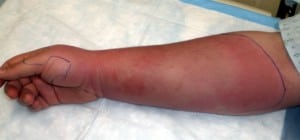| Author | Affiliation |
|---|---|
| Brian Cashin, MD | Madigan Army Medical Center, Department of Emergency Medicine, Tacoma, WA |
| Nicholas Allan, MD | Madigan Army Medical Center, Department of Emergency Medicine, Tacoma, WA |
| Christopher Kang, MD | Madigan Army Medical Center, Department of Emergency Medicine, Tacoma, WA |
A 31-year-old Caucasian female presented to the emergency department (ED) with chief complaint of a gradually progressive right extremity rash for past two days. The patient described a warm, red area over the dorsum of her forearm. The lesion began as a small spot that overnight came to involve most of the arm. The patient, who had similar episodes in the past on her back, stomach, and legs, had been on multiple topical and systemic steroids and antihistamines for this same presentation and had just finished a prednisone taper.
Physical exam revealed a tender, erythematous blanching plaque with associated dermal edema (Figure). Careful examination of the arm revealed no signs of ulceration, skin breakdown, streaking, or lymphadenitis. There was no adenopathy. Although the patient had tenderness and subjective paresthesias of that extremity, she had intact two-point sensation distal to the affected area. The decision was made not to Stryker her compartments for fear of spreading the infection into the subcutaneous tissue and muscle. There were intact distal pulses and adequate capillary refill while in the ED. Pain control was achieved while in the department, and the patient was given systemic steroids and antihistamines. Dermatology was consulted, and the patient was given a tentative diagnosis of Wells syndrome.

Wells syndrome was first described in 1971 as “recurrent granulomatous dermatitis with eosinophila.”1 Affected individuals typically present with pruritic erythematous plaques over a two- to three- day period. These plaques will then resolve without scarring over the next two to eight weeks.2 Although the lesions will heal without medication, it has been shown that treatment with systemic corticosteroids will decrease the duration of symptoms. Wells syndrome is also a benign condition that usually does not have systemic manifestations. Patients may describe malaise and arthralgias but rarely fever.
Histopathologically, biopsy of the plaques demonstrate heavy eosinophilic infiltration. The lesions are very edematous and contain a complex mixture of degranulating and degenerating eosinophils.3As the lesions resolve, one can observe a grayish and atrophic appearance of the skin.4 This eosinophilic cellulitis will usually recur multiple times in a patient’s lifetime. Different reviews speculate that arthropod bites, fungal infections, immunological disorders, myeloproliferative conditions, such as lymphoma and leukemia, and drug reactions may all be linked as possible associated conditions in patients with Wells.2,4
Wells syndrome is an important disease entity for emergency physicians to consider in a patient who presents with recurrent puritic lesions. The differential diagnosis includes common processes such as bacterial cellulitis, contact dermatitis, envenomations, and drug reactions,2 as well as less common entities including erysipelas, hypereosinophilic syndrome, chronic urticaria, granuloma annulare, and Churg-Strauss syndrome.5
Wells’ syndrome is a rare condition with about 80 cases reported in the literature. Prognosis is excellent and most recover without difficulty, although lesions may recur later. Lesions take weeks to months to resolve, usually without scarring. Dermatology should be consulted for skin biopsy if considering this diagnosis.
Footnotes
Supervising Section Editor: Sean Henderson, MD
Submission history: Submitted July 18, 2009; Accepted July 31, 2009
Full text available through open access at http://escholarship.org/uc/uciem_westjem
Address for Correspondence: CPT Brian Cashin, MD; Madigan Army Medical Center, Bldg. 9040 Fitzsimmons Dr., Tacoma, WA, 98401
Email: brian.cashin@us.army.mil
Conflicts of Interest: By the WestJEM article submission agreement, all authors are required to disclose all affiliations, funding sources, and financial or management relationships that could be perceived as potential sources of bias. The authors disclosed none.
REFERENCES
1. Wells GC. Recurrent granulomatous dermatitis with eosinophilia. Trans St John’s Hosp Dermatol Soc. 1971;57:46–51.
2. Falagas ME, Wergidis PI. Narrative review: diseases that masquerade as infectious cellulitis. Ann Intern Med. 2005;142:47–55. [PubMed]
3. Green WH. Recurrent, pruritic dermal plaques and bullae. Arch Dermatol. 2007;146:791–6.[PubMed]
4. Melski JW. Wells’ syndrome, insect bites, and eosinophils. Dermatologic Clinics. 1990;8:287–292.[PubMed]
5. Brown J, Schwartz RA. Wells Syndrome (Eosinophilic Cellulitis) eMedicine 2007.www.emedicine.com/derm/TOPIC908.HTM Last updated Feb. 1, 2007.


